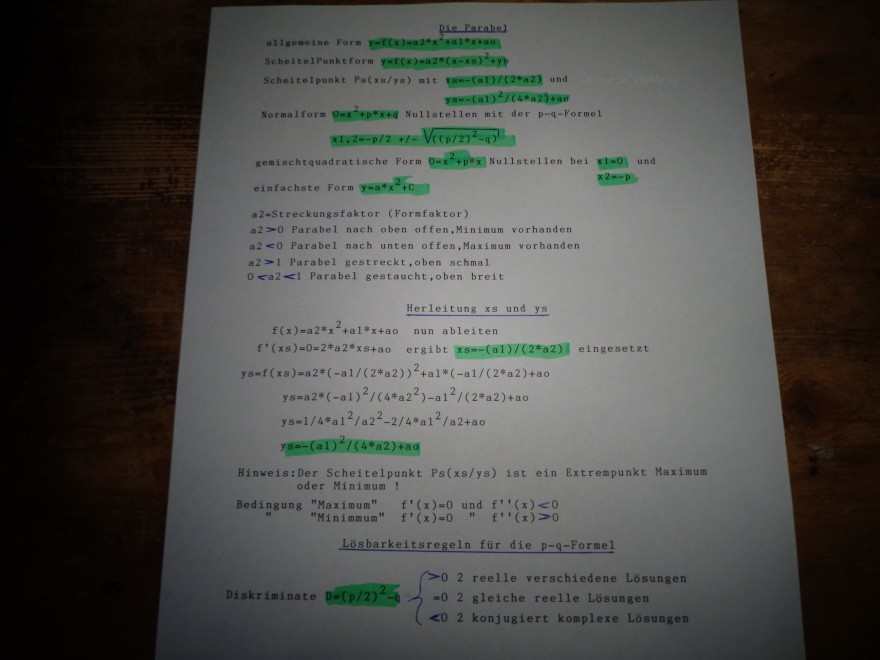allgemeine Form der Parabel y=f(x)=a2*x²+a1*x+ao
Scheitelpunktform y=f(x)=a2*(x-xs)²+ys
Scheitelpunkt Ps(xs/ys) mit xs=-(a1)/(2*a2) und ys=-(a1)²/(4*a2)+ao
f(x)=-0,5*x²+2,5*x+0
a2=-0,5 und a1=2,5 und ao=0
xs=-(2,5)/(2*(-0,5))=2,5 m und ys=-(2,5)²/(4*(-0,5))+0=3,125 m
Der Lkw muß in der Mitte fahren → Breite des LKW b=2,20 m also x1=2,5 m-2,20 m/2=1,4 m
x2=2,5 m-2,20 m/2=3,60 m
f(x1)=f(1,4)=-0,5*1,4²+2,4*1,4=2,52 m>2,40 m passt
Infos,

Text erkannt:
Die Parabe] af 1geneine Form y=f(x)=a2∗x2+a1+x+a0 Scheitelpunkt form y=f(x)=a2∗(x−x8)2+y} Scheite1punkt Ps(xs/ys)mitxse−(a1)/(2∗a2) und
yse−(a1)2/(4∗a2)+ad
Normalform 0=x2+p∗x+d Nullstellen mit der p-q-Formel x1,2=−p/2+/−((p/2)2−q)
gemischtquadratische Form 0=x2+p∗x] Nu11stellen bei x1=0 und
einfachste Form y=a∗x2+c
a 2-Streckungsfaktor (Formfaktor) a2>0 Parabel nach oben offen, Minimum vorhanden a 2<0 Parabel nach unten offen,Maximum vorhanden a2>1 Parabel gestreckt,oben schmal 0 <a 2<1 Parabel gestaucht,oben breit
Herleitung xs und ys f(x)=a2∗x2+a1∗x+a∘ nun ableiten
f′(xs)=0=2∗a2∗xs+a0 ergibt xs=−(a1)/(2∗a2)] eingesetzt
ys=f(xs)=a2∗(−a1/(2∗a2))2+a1∗(−a1/(2∗a2)+a0
ys=a2∗(−a1)2/(4∗a22)−a12/(2∗a2)+a0
ys=1/4∗a12/a22−2/4∗a12/a2+ao
ys=−(a1)2/(4∗a2)+ad
Hinweis:Der Scheitelpunkt Ps(xs/ys) ist ein Extrempunkt Maximum oder Minimum
Lösbarkeitsregeln für die p-q-Formel
Diskriminate D=(p/2) 2−p⎩⎪⎨⎪⎧⎩⎪⎨⎪⎧>02 reelle verschiedene Lo¨sungen =02 gleiche reelle Losungen <02 konjugiert komplexe Losungen
Plotlux öffnen f1(x) = -0,5·x2+2,5·xf2(x) = 2,52Zoom: x(-5…10) y(-5…5)x = 2,5x = 1,4x = 3,6